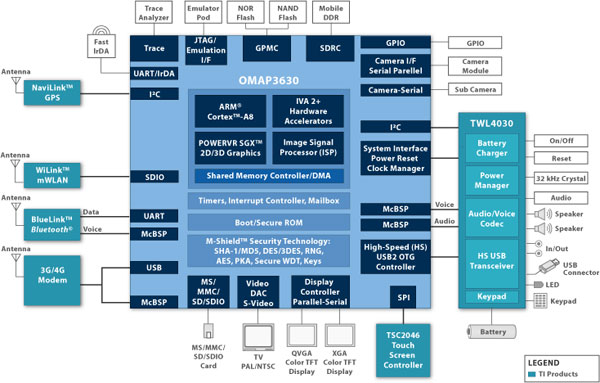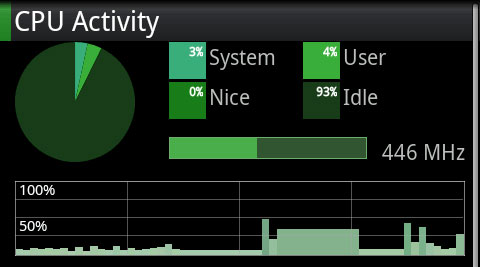Motorola Droid X: Thoroughly Reviewed
by Brian Klug on July 20, 2010 4:27 PM EST- Posted in
- Smartphones
- Motorola Droid X
- OMAP
- Mobile
Years ago, before we hit the power wall, CPU innovation happened at a slow but steady pace. Every five years or so we’d get a new microprocessor architecture and every couple of years we’d get smaller transistors.
The smaller transistors made chips run cooler and at higher clock speeds. The shrink in die area also paved the way for new features, but between major architectural shifts those features normally came in the form of larger caches.
Texas Instruments’ move from the OMAP 3430, used in phones like the Palm Pre, to the OMAP 3630 used in the Droid X is reminiscent of this sort of steady progress I mentioned above.
The OMAP 3430 was built on a 65nm process (like Qualcomm's Snapdragon), while the 3630 is a 45nm shrink (like Apple's A4). Architecturally the two SoCs are very similar. They both use a standard ARM Cortex A8 CPU paired with an Imagination Technologies PowerVR SGX 530 GPU. The two SoCs fit in the same size package (12mm x 12mm BGA) and are ball compatible. If a customer wanted to, it could simply drop in a 3630 into an existing 3430 design with minimal engineering efforts.
Note that the most direct competitor to the 3630 is Qualcomm’s Snapdragon. While TI uses a standard Cortex A8 core from ARM, Qualcomm designed its own low power ARMv7 based core that is similar, but not identical to the Cortex A8. Both are dual-issue, in-order architectures - they’re like the original Pentium, but in your phone. Qualcomm also integrated the cellular modem into the Snapdragon SoC while TI’s OMAP 3 is a strict application processor - the modem is housed in a separate chip.

On the CPU side TI doubled the L1 cache of the 3430 to 64KB (32KB instruction, 32KB data). The L2 cache remains unchanged at 256KB. We won’t get a larger L2 until the OMAP 4, which will ship with a 1MB L2 shared among its two cores. There are the usual tweaks and bug fixes which may improve performance per clock a little bit over the 3430, but overall the 3630 just gets a larger L1 as a result of the die shrink - oh and a much higher clock speed.
The Cortex A8 now runs at up to 1GHz. The OMAP 3430 topped out at 800MHz in shipping configurations but most vendors ran it at sub-600MHz speeds to save power. The 3630 in the Droid X runs at a full 1GHz. It's worth pointing out that Qualcomm was able to hit 1GHz on a similar architecture at 65nm by designing its core from the ground up. There's clearly value in these custom designs from a performance and time to market standpoint. These advantages will only become more critical as the SoC performance wars heat up.
Power Consumption
The OMAP 3 as well as Qualcomm’s Snapdragon SoC support dynamic voltage and frequency scaling. Based on application demand and cues from the OS the CPU clock speed and voltage can vary. The Cortex A8 in the OMAP 3630 will drop down to the low 300MHz range when idle at the Android home screen and ramp all the way up to 1GHz when needed.

TI's OMAP 3630 running at full tilt

...and automatically underclocked to 446MHz under lighter load
This is nothing unique to the OMAP 3630, but it shows that frequency and voltage scaling is alive and well in Android.
TI supports full power and clock gating. All major IP blocks are placed on their own power islands, so based on input from the OS the CPU, GPU, video decoder, etc... can ramp down depending on the application needs at the time. The power and clock gating is no more granular in the 3630 than it was in the 3430. What has changed however are operating voltages.
While the 3430 needed 1.35V to hit 720MHz, the 3630 can reach 1GHz at around 1.26V. That still sounds a bit high to me but at the same clock speed, thanks to voltage scaling, you can drop power by around 30% compared to the 3430.
Coupled with the dynamic voltage/frequency scaling of all OMAP 3 parts this means that overall power efficiency should be better on the 3630 vs. the 3430. The added CPU performance in the form of larger L1 caches and a higher clock speed should make tasks complete quicker and allow the 3630 to get to a lower voltage state than the 3430 was ever able to reach.
Samsung has already shown off 1.2GHz+ versions of its Cortex A8 based SoC at 45nm, so I would expect to see higher clocked versions of the 45nm OMAP 3 family to follow at some point in time.










89 Comments
View All Comments
numberoneoppa - Wednesday, July 21, 2010 - link
Can't wait, I look forward on your impressions on Samsung's touchwizz overlay, from what I can tell, it rather hurts the GUI performance. :(Zebo - Wednesday, July 21, 2010 - link
Would be nice if these smart phones reviews had a large table for quick access to pro's and con's of each phone.Each box/catagory in the table could be based on 1-10 with a little narrative or to as simple as just check mark for superiority.
Hey it's a perfect review so i had to make something up to nag about:)
Droid X seems to be top dog android...- Evo is unsuitable you actually USE the phone's unlimited plan with it's poor batt life but just as nice too. Hard to pick.
radium69 - Wednesday, July 21, 2010 - link
Thank you Brian & Anand, for this in depth review.I find your articles to be very interesting, and well written!
Keep up the good work!
mvmorr01 - Wednesday, July 21, 2010 - link
Thanks, cool app!LoneWolf15 - Wednesday, July 21, 2010 - link
(quote)"The Droid X is the spiritual successor to last year’s Droid."(/quote)Actually, I'd say the upcoming Droid II is the sequel, as it has a fully tactile keyboard, as opposed to the touchscreen Droid X. I'd say the Droid X is a new product rather than a successor.
I'm waiting to see what the Droid II can do --I won't buy a smartphone that doesn't have a physical keyboard.
tbuck79 - Wednesday, July 21, 2010 - link
I have a Droid X, the WiFi is terrible on my Netgear Router but at work on a Linksys router it's fine (both are single band N), however, using any WiFi the distance is really bad with the X, compared to an iPhone 4 in my other hand, the iPhone can get MUCH farther away from the AP than the X, could you guys see if there is an actual problem with range on the X?WaltFrench - Saturday, July 24, 2010 - link
you must be holding the X the wrong way.Ratman6161 - Wednesday, July 21, 2010 - link
The Droid and the Doid X are both Android 2.1 and both are soon to be upgraded to 2.2 (mine already is). The run the same apps and do the same things (weather or not you like Motoblur and find it an advantage is up to you). The Droid will basically do everything the Droid X does - just not quite as fast. So "obsolete" is a matter of perspective. That's what Verizon and Motorola would like us to think. They just love people like your friend who ditched his Droid for an Incredible and now wants to ditch the incredible for a Droid X.Lets face it - it's evolution not revolution. If you are always trying to have the latest cool gadget, you are always going to end up disappointed and with a much thinner wallet.
Good review though. If I were buying today I'd probably go with the X. But with another year to go before the next upgrade, something else will come along long before I'm ready to buy.
digipro55 - Wednesday, July 21, 2010 - link
Incredibly well written and through review. I can admit I didn't understand all the jargon in the performance tests but it certainly is a wealth of knowledge concerning the best Android phone on the market. Thanks again for a very informative reviewAikouka - Wednesday, July 21, 2010 - link
Hey Brian, just to let you know, the mini-HDMI to HDMI cables are available at Monoprice, but of course it sounds like you were looking for one ASAP from a B&M store :). So I guess if you know you'll need one, you can order one, but it also looks like they're not terribly commonplace as you mentioned as they're kind of expensive on Monoprice compared to standard HDMI cables.